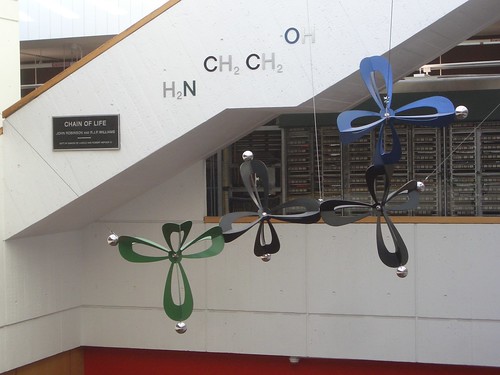THE RHS CHOIR TRIP TO OHIO!!!

Welcome to the world of the traveling PBWiki shirt! This blog was created by high school biology classes at Randolph High School. The idea came about one day when the shirt was just about to be offered up as a prize in a wiki competition, when students and instructor, alike, decided it was much too cool to be awarded to one single lucky soul. Then the idea was born! Join the PBWiki shirt in its remarkable adventures... be careful though... you might learn something on the way!




 H2N CH2 CH2 OH is the organic compound for Ethanolamine. Because it said "Chain of Life," one would think it may be an Amino Acid, but it is not. It is the second most abundant group for phosopholipids, but the reason why it says "Chain of Life" next to it, remains unclear to us.
H2N CH2 CH2 OH is the organic compound for Ethanolamine. Because it said "Chain of Life," one would think it may be an Amino Acid, but it is not. It is the second most abundant group for phosopholipids, but the reason why it says "Chain of Life" next to it, remains unclear to us.
 uld shine through the roof, and the plant would use it for photosynthesis. If you break down the word photosynthesis into "photo" and "synthesis," the word photo means light, and synthesis means to build. Plants need photosynthesis as an energy source. Sunlight, water, and carbon dioxide enter the chloroplasts in the plant cells, and the sunlight and water go to the Grana. This is where light reactions occur. From that, O2, NADPH, and ATP is produced. The O2 is given off by the plant. The ATP moves with CO2 to the Stoma, where the Calvin Cycle occurs. Light Independent Reactions make sugars, along with ADP+P and NADP+. The sugars created are used for energy, in which the Stoma absorbs.. Like most living things, "food" and energy help the organism to grow, like this plant. It appears to have been nourished well, with sunlight, water, and carbon dioxide.
uld shine through the roof, and the plant would use it for photosynthesis. If you break down the word photosynthesis into "photo" and "synthesis," the word photo means light, and synthesis means to build. Plants need photosynthesis as an energy source. Sunlight, water, and carbon dioxide enter the chloroplasts in the plant cells, and the sunlight and water go to the Grana. This is where light reactions occur. From that, O2, NADPH, and ATP is produced. The O2 is given off by the plant. The ATP moves with CO2 to the Stoma, where the Calvin Cycle occurs. Light Independent Reactions make sugars, along with ADP+P and NADP+. The sugars created are used for energy, in which the Stoma absorbs.. Like most living things, "food" and energy help the organism to grow, like this plant. It appears to have been nourished well, with sunlight, water, and carbon dioxide.


This is the journey that a little cocoa bean takes to become the delicious chocolate from Hershey’s!
Cocoa starts from the cocoa tree (Theobroma cacao). This tree grows in South America, Africa, and Indonesia. This tree grows a fruit about the size of a small pineapple. Inside this fruit are 20 – 40 seeds, otherwise known as cocoa beans.
The beans are harvested from the trunks and branches of the cocoa tree with a curved knife or a long pole. They are harvested when green, as this is when the pods are ripest and the beans will have the best aroma and flavor. The pods are opened with a machete and the pulp and cocoa seeds are removed. The rind is discarded. The pulp and seeds are placed together in bins for about a week. This “sweats” the pulp and seeds and the pulp liquefies as it ferments. They drain the fermented pulp away, and leave the cocoa beans to be collected. Fermenting the beans is where the flavor comes from. Then they dry the beans for roasting.
Then the beans are cleaned and roasted to bring out the flavor. Then, the roasted beans are winnowed. This removes the meat (a.k.a. the nib) of the bean from the shell. Then the nibs are ground and a viscous liquid forms, called chocolate liquor (there is no actual liquor though). This chocolate liquor is pure unsweetened chocolate. It is very bitter. Ingredients are added to the chocolate liquor like sugar, milk, and flavors like vanilla.
The chocolate goes through a machine that mills the chocolate, or massages and blends the ingredients together. This can take from 2 to 6 days.
Then the chocolate is tempered, heating the chocolate slowly, and then letting it cool, allowing the molecules solidify in an orderly fashion. If the chocolate is not tempered properly, the chocolate will separate. The chocolate is poured into molds, cooled, and sent to packaging. Then it hits the stores for everyone to enjoy!
I had a great day with Sara and Julia at Hershey Park. Even though we were on an Orchestra field trip in an amusement park, biology was still in our mines as we gained even more information relating to our in-class studies! See you all soon!
XOXO, Wilhemina